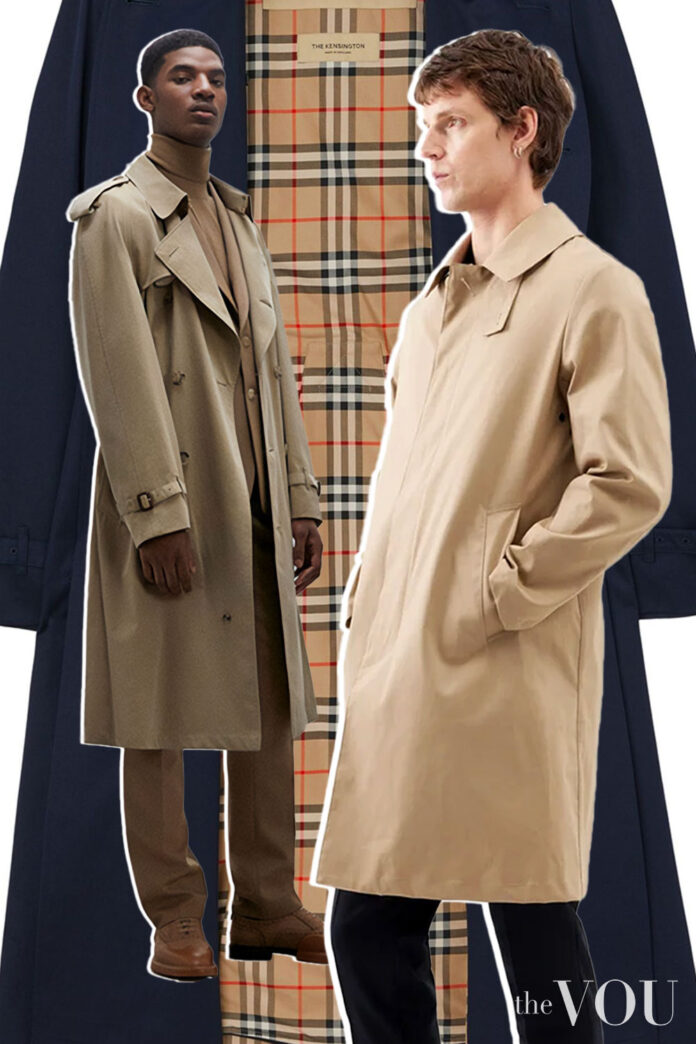Quick Answer
To achieve a classic, wealthy ‘Old Money’ look with a trench coat, focus on these essential styling elements:
-
- Choose a traditional double-breasted trench in 100% cotton gabardine, preferably knee-length
- Opt for classic colours like camel, khaki, stone, navy blue or black
- Ensure it features authentic details: raglan sleeves, epaulettes, gun flap, D-ring belt, and checked lining
- For formal events, pair with suits in complementary colours (camel with navy, khaki with charcoal)
- For business wear, try monochromatic looks like grey trench with grey suit or navy trench with navy slacks
- For casual settings, combine with quality basics: navy trench with blue jeans and white trainers or tan trench with dark wash jeans and Chelsea boots
- Consider vintage Burberrys’ (pre-1999) or Aquascutum for authentic heritage quality
Key Points to Remember
- Authentic trench coats should feature proper details: 100% cotton gabardine, raglan sleeves, double-breasted closure, epaulettes, gun flap, D-ring belt, and checked lining
- Avoid leather trench coats due to negative historical associations
- Choose a looser fit that allows for layering over suits or other bulky garments
- For vintage Burberry, look for “Burberrys'” with an apostrophe (pre-1999) – these were made in England and offer superior quality
Want to learn more? Continue reading the full article below ↓
With a classic double-breasted silhouette and decades of heritage, the trench coat is a must-have to any classic gentleman’s wardrobe.
In this article, you’ll learn how to choose and style a classic trench coat to create a timeless Old Money look.
Correct Trench Coat for a Classic Look

Many different options profess to be authentic trench coats, but the reality is that many of them are not.
Whether it’s the knee-length minimum or the belted waist, the DNA of a genuine trench coat relies on a very particular set of features, as detailed below:
Trench Coat Fabrics

Although originally rubberised, traditionalists will argue that there is only one choice of trench coat fabric: 100% cotton gabardine, invented by Thomas Burberry.
Tightly woven of a worsted cotton, it is both lightweight and durable.
Both the yarn and finished cloth are waterproofed, achieving remarkable water-repellent properties.
There was a time when leather was frequently used for trenches.
However, a leather trench coat is best avoided due to negative associations from the Second World War and being used as a costume for villainous characters.
While Gore-Tex or Event fabric could also be used, they aren’t as elegant as traditional garments.
Raglan Sleeves

The raglan sleeve debuted in the 19th century, and just like the Chesterfield coat, it owes its name to an aristocrat: FitzRoy Somerset, 1st Baron Raglan.
The purpose of the diagonal sleeve heads is to aid mobility and ease of putting the coat over bulky layers.
While traditionalists would choose the raglan sleeve, trench coats with traditional suit-like sleeve heads or a combination of both are also possible.
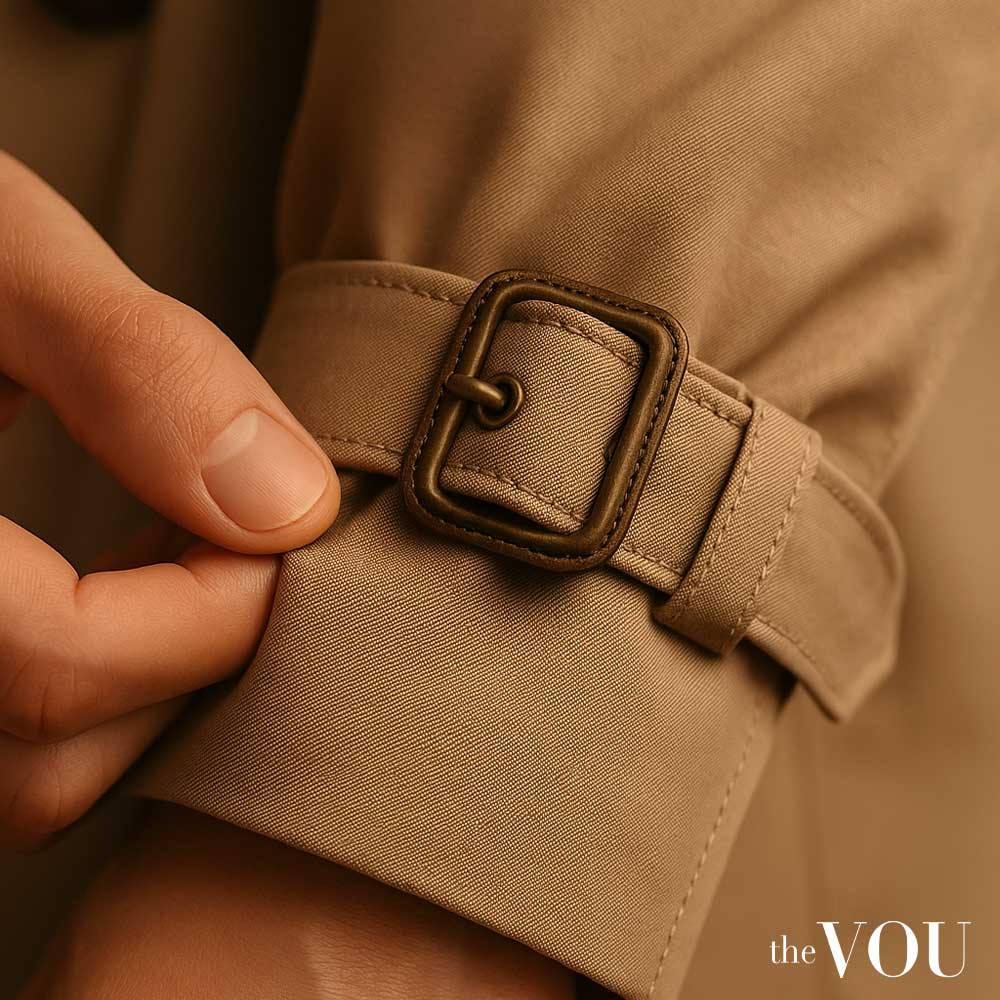
At the base of the sleeve, you should also find straps at the cuffs that can be tightened to keep out the elements.
Double Breasted Closure

From its military origin, a trench coat is traditionally double-breasted and has ten front buttons.
Of course, all kinds of double-breasted and single-breasted versions are available with multiple button & belt configurations, but the first coat has always been the 6×2 DB cut.
Epaulettes

The infamous shoulder tabs often seen on military uniforms also found their way on a trench coat, but they were not added merely to indicate rank.
Rather, they were used to secure gas masks, gloves, or whistles.
A Gun Patch or Storm Flap

The gun patch fulfilled two functions. It could serve as a gun flap for a rifle’s recoil, but more importantly, it prevented rainwater flowing down the shoulders from entering the inside of the gun.
This feature is somewhat mirrored with a deep back yoke that allows water to cascade away from your back, keeping you drier.
This feature is unique to the trench, as it is not found on many other garments.
Throat Closure

Just below the large collar, you will find a hook-and-eye that allows you to close the collar easily.
It is often secured with a strap and buckle system hidden underneath the collar, a feature also known as a throat latch.
D-Ring Belt

Initially, the belt with its D-rings was used to suspend equipment such as grenades or a sword.
Although the sword is no longer used with a trench coat, the belt enables you to create an attractive silhouette by sinching and defining the waistline.
The D-rings remain as a memory of the original military feature.
Leather buckles should be found on all of the trench coat’s belts.
Technically, metal buckles would perform just as well, but the leather helps prevent premature wear to the trench coat’s fabric.
Pleated “Wedge” Back
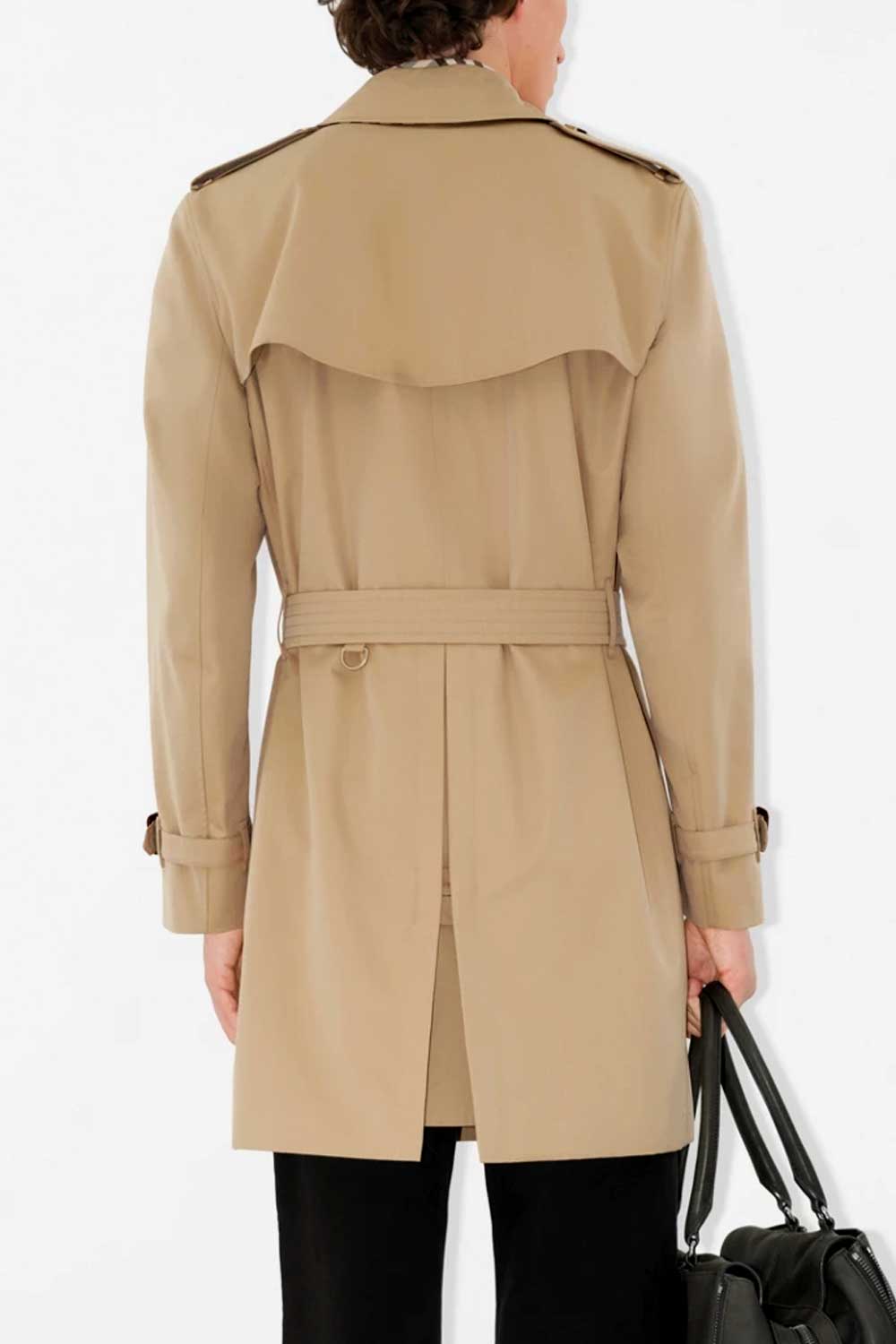
For you to be able to move freely, your trench coat needs a vent.
It was tailored with a wedge, a form of box pleat to keep you dry and warm.
Wedged vents are great because they block the wind and rain while allowing added movement.
A trench coat’s vent typically features a button closure to protect you from the elements.
Storm Pockets

The angled storm pockets can be buttoned up from the outside to keep out the rain.
All proper trench coats have through pockets that can be reached inside and outside.
This is a great feature when travelling because you can wear the coat buttoned or unbuttoned and always have access to your wallet or passport.
Checked Lining

Traditionally, trench coats feature a classic checked lining.
For the cooler days, you can also find trench coats with a removable wool lining that can be attached with buttons, making it a particularly versatile piece of outerwear.
Often, these liners have a mixture of fibres, such as 95% wool with 5% camel hair or even a cashmere blend.
Classic Colours

The most traditional trench coat colour is camel or khaki.
Other popular colours include sand, stone, navy blue or black.
Today, you can find them in any other colour under the sun.
Remember that the lighter the color the more quickly it is stained.
For that reason, Raphael often travels with a darker trench coat to mitigate the risk of potential stains.
Trench Coat Fit

Most trenches are not skin-tight since they are worn over other garments, such as uniforms, suits, sweaters, etc.
Therefore, a trench coat is designed to give extra room and not be tailored close to the body.
If you wish to wear a suit underneath it, bring a suit when you try coats on, and wear it with and without your suit coat to ensure you’re getting the fit you want.
Also, decide whether you want a detachable liner, as adding one after the fact is not as easy.
The sleeve should reach the root of your thumb so your sleeves underneath are covered completely, and your shirt cuff should remain out of view when you move around.
Anything longer than that will make you look like you haven’t yet made it to the alterations tailor.
Remember, there is not one traditional length for a trench coat.
Advertisements and pictures from the past range from above the knee to the mid-calf and sometimes even to the ankle.
The most versatile coats are worn at about knee length.
Trench Coat Alterations
As with most garments on the rack, you can make them smaller by one or two sizes, but rarely bigger.
Never have extreme alterations done since they will distort the proportions of the belt lines, buttons, pockets, etc., and despite all your efforts, you will look unintentionally awkward.
Single Breasted vs Double Breasted
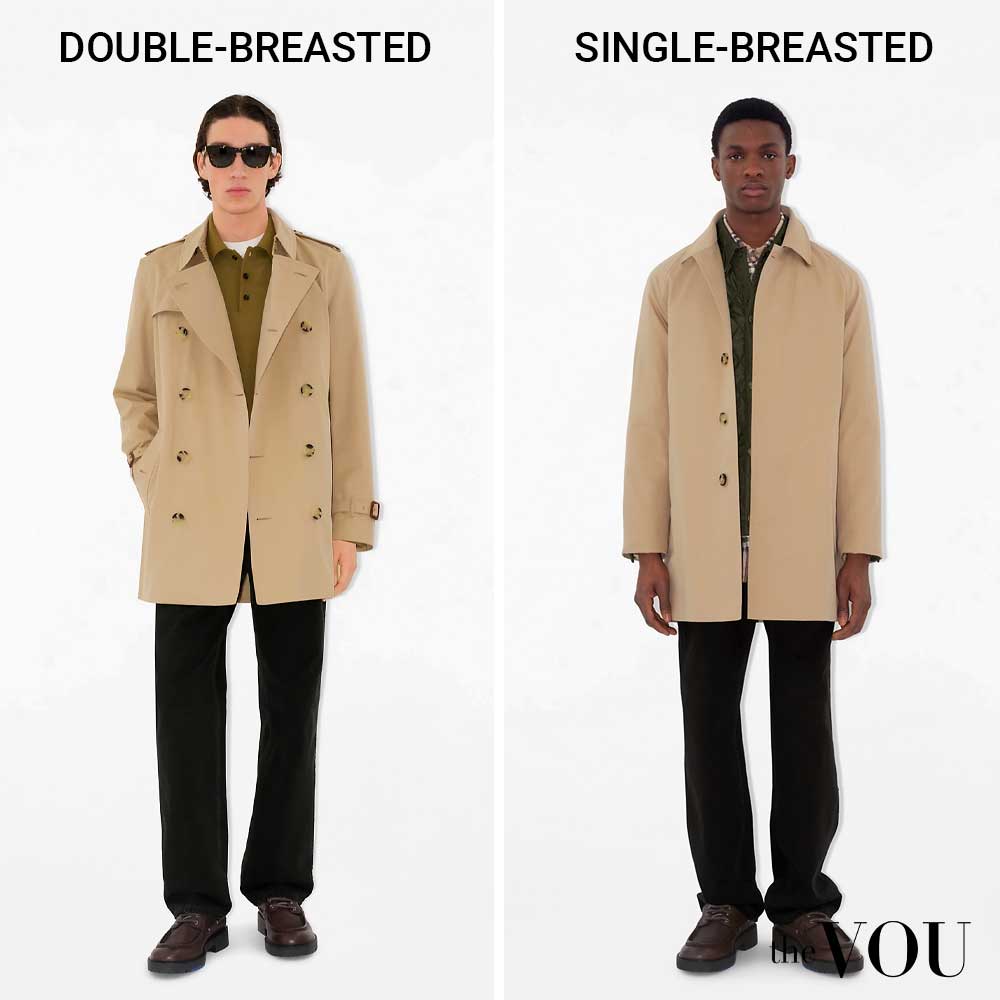
Modern trench coats come in both varieties, so which should you choose? If you want to stay true to the original trench coat style, go for a double-breasted version.
A double-breasted version offers more chest protection and warmth, with extra fabric to cover you.
A double-breasted silhouette may also make your chest and waist look smaller.
However, on some men, it may end up looking too bulky, in which case they should stick to single-breasted.
A single-breasted trench coat would also be a better choice if you don’t need the extra fabric protection and are looking for a light spring/fall coat.
Styling Trench Coats by Occasion
Trench Coats for Formal Events

The trench coat is stylish, but how should men wear it to achieve an old-money, silent luxury look?
The most effective dress combination is pairing a trench coat with a suit.
Colour-wise, the classic camel colour looks great with almost any suit and will always have a timeless look.
But if you want to try something different, opt for darker colours like khaki, which looks amazing with navy, black, and charcoal suits.
A black or navy trench with a grey double-breasted suit creates a darker and more dramatic feel – almost Peaky Blinders-esque.
Regarding formal events, it’s better to stick to traditional, classic-coloured trench coats, as this will better match the dress code and give you a more refined air.
Trench Coats for Business Events

Whether you have a business formal or casual dress code, a trench coat will complement your work clothes.
If you must wear a full suit to work, try a trench coat in a matching colour for an ultra-stylish monochrome look. Break up the colour with your shoes and possibly a briefcase.
For example, a grey trench coat and suit with brown shoes.
If full monochrome isn’t your thing, try a slight variation by choosing similar tones, like a charcoal trench coat with a navy suit or a camel trench coat with a brown suit.
If you have a more relaxed dress code and you like to mix and match, try some of the following options:
- Navy trench coats with light blue shirts, grey slacks, and brown chukkas.
- Camel trench coats with navy slacks, white shirts, burgundy ties, and oxblood boots.
- Khaki trench coats over white business dress shirts, black slacks, and black monk straps
Trench Coats for Casual Occasions

Trench coats can elevate any outfit and give it the perfect high-low balance.
Especially great for spending your weekend out and about, trench coats are the ideal companion from morning breakfast to afternoon errands to late evening at the pub.
Match with a cool and comfortable outfit, such as the top picks below:
- Navy trench coat, blue jeans, white T-shirt, and white tennis sneakers.
- Tan trench coat, brown cardigan layered over a white t-shirt, chinos, and brown cap-toe boots.
- Burgundy trench coat, a slightly unbuttoned or untucked shirt, dark blue jeans or chinos, and black brogue boots.
- Grey trench coat, black sweater or hoodie, black jeans, and white sneakers.
With all these variations, you can play around with colours to find what matches best, but you can’t go wrong with classic colours like black, white, and grey for your underlayers.
They will be easier to match with your trench coat, especially if you choose a brighter-colored one.
Add accessories like beanies and scarves when the weather is colder, but always wear the scarf with a classic knot underneath your trench coat.
Trench Coats for Dates

Whether heading to the movies, a cosy restaurant, or an upscale lounge, a trench coat will help elevate your date night look and give you Humphrey Bogart vibes.
Here are some cool combinations to try:
- Camel trench coat, light blue shirt, dark wash jeans, and chukka or Chelsea boots.
- Khaki trench coat, black turtleneck, black jeans, and black Chelsea boots.
- Navy trench coat, grey sweater layered over a white shirt (tie optional), dark wash jeans, and boots of choice.
Of course, you can dress your outfit up or down depending on what you’re doing for the date, so feel free to take inspiration from any other suggestions.
If you’re going somewhere fancy, you might want to wear something tailored, or if you’re keeping things relaxed, you can make your outfit more casual.
Styling Trench Coats by Colour
Navy Blue Trench Coats
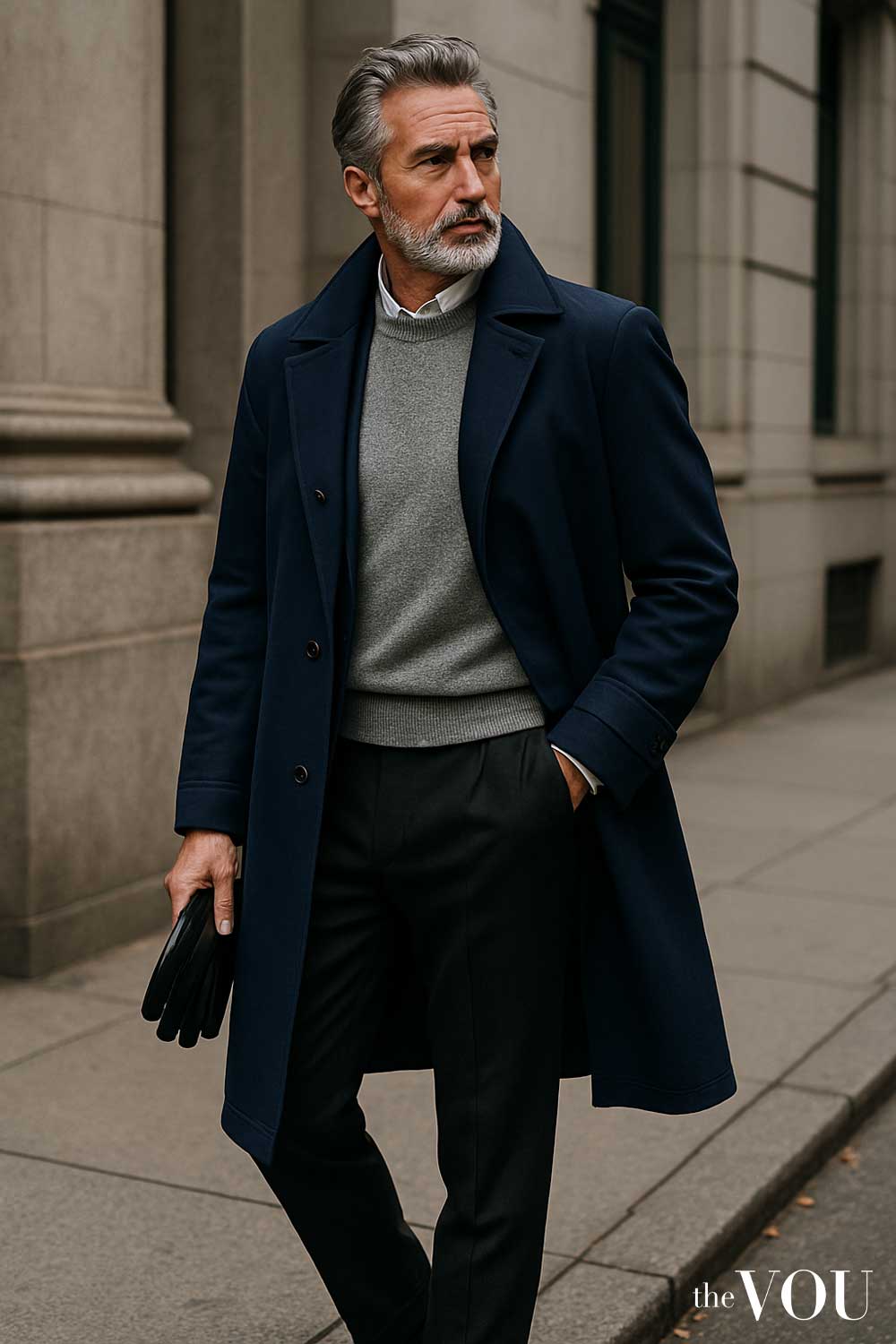
Navy is a rich and elegant colour that looks amazing during the fall and winter.
A navy trench coat is the perfect cover-up for navy suits, leaving you with a stylish monochrome look.
Another formal way to wear a navy trench coat is with a grey suit.
Navy trench coats also work well with more casual garments such as blue jeans and white shirts (if it’s warm enough) or a sweater if it’s cooler.
You can also swap the jeans for tan or grey chinos in the Fall/Winter or white in the Spring for a brighter look.
Some colours that look great with navy (for shirts and sweaters) are white, hunter green, brown, beige/tan/camel, grey, olive, or lighter shades of blue.
And in case you were wondering – yes, you can wear navy with black.
Add something grey for a cool and smart colour palette, such as a grey sweater with black pants and accessories (shoes, scarf, gloves).
Grey Trench Coats

Grey is a versatile shade that works well for any season.
A grey trench coat is an excellent layering piece for a lighter-coloured suit, like beige or pale blue, in the spring.
You can also pair a dark grey or charcoal trench coat with dark suits (black, navy) or create a monochromatic effect with a grey suit in a different shade—this works well both ways.
For a more casual feel, use your grey trench coat to dress up your favourite jeans and t-shirt combo for a stylish weekend look in the fall or spring.
If you prefer chinos, a grey trench coat will work with just about any colour: beige, navy, black, or khaki. As for shirts and sweaters, choose white, black, burgundy, olive, blue, mustard, or beige.
Grey also works as a great neutral backdrop for checks, so you can always wear checked chinos or trousers are a great bet if you like prints.
If the rest of your look is fairly neutral, you can also add bright pops of colour like red or cobalt blue through accessories (scarves, ties).
Camel Trench Coats

Camel or beige are the classic trench coat colours.
Light and neutral, these shades are ideal in the Fall or Spring. They match greatly with any suit colour, especially light-coloured or check suits.
In the fall, camel looks amazing with traditional earthy colours as it falls in the same colour family.
You can combine your camel trench coat with khaki, rust, mustard, and brown – this works for shirts, sweaters, or chinos.
For example, a mustard or rust sweater with dark khaki chinos and a camel trench coat.
You can also treat camel as a regular neutral during other times of the year and wear it with white, black, grey, or navy.
Wear your camel trench coat over a crisp white shirt and navy, black, or grey chinos for a timeless outfit.
Black Trench Coats

Black is a classic that goes well with everything.
You can wear your black trench coat over any solid or printed suit or with more casual outfits.
Stick to all-black everything for the dark and mysterious look.
For easy neutrals, wear a white or beige shirt or sweater with black bottoms, or if you prefer something brighter, choose a more colourful piece instead.
For a great transitional look, layer your black trench coat over a light-coloured outfit (white or beige). Checked or coloured trousers create contrast.
You can wear a T-shirt, shirt, or sweater on top, depending on how casual or formal you want to look.
Trench Coat Brands and Stores
Ready To Wear Trench Coats

The easiest and quickest route to acquire a trench coat is via a store that sells ready-to-wear variations.
Burberry, Aqascutum, and Mackintosh still carry original styles but will likely cost more than online retailers like Assos.
There is also a good resale market for Burberry trench coats, but be careful not to end up with a fake.
Vintage Trench Coats

Old Burberry’ or Aquascutum coats are the real deal and should last you for years, but finding one in good condition can be a labour of love.
Raphael spotted his first one for 125 EUR in a men’s vintage store in Germany, so it’s worth investigating what you like and looking for.
Alternatively, you can look on eBay, where you can always find a plethora of different trench coats.
Bespoke Trench Coats

If your tailor can source the right kind of gaberdine and the wool liner as well as the pattern, a custom trench is certainly an option that is hardly more expensive than the established brands.
Burberry Trench Coat Shopping Tips
Burberry trench coats are designer investment pieces rather than practical garments.
Therefore, you might want to try finding a vintage-quality Burberry.
These were the durable classics that contained all the defining details.
Not All Burberry Trenches Are Alike
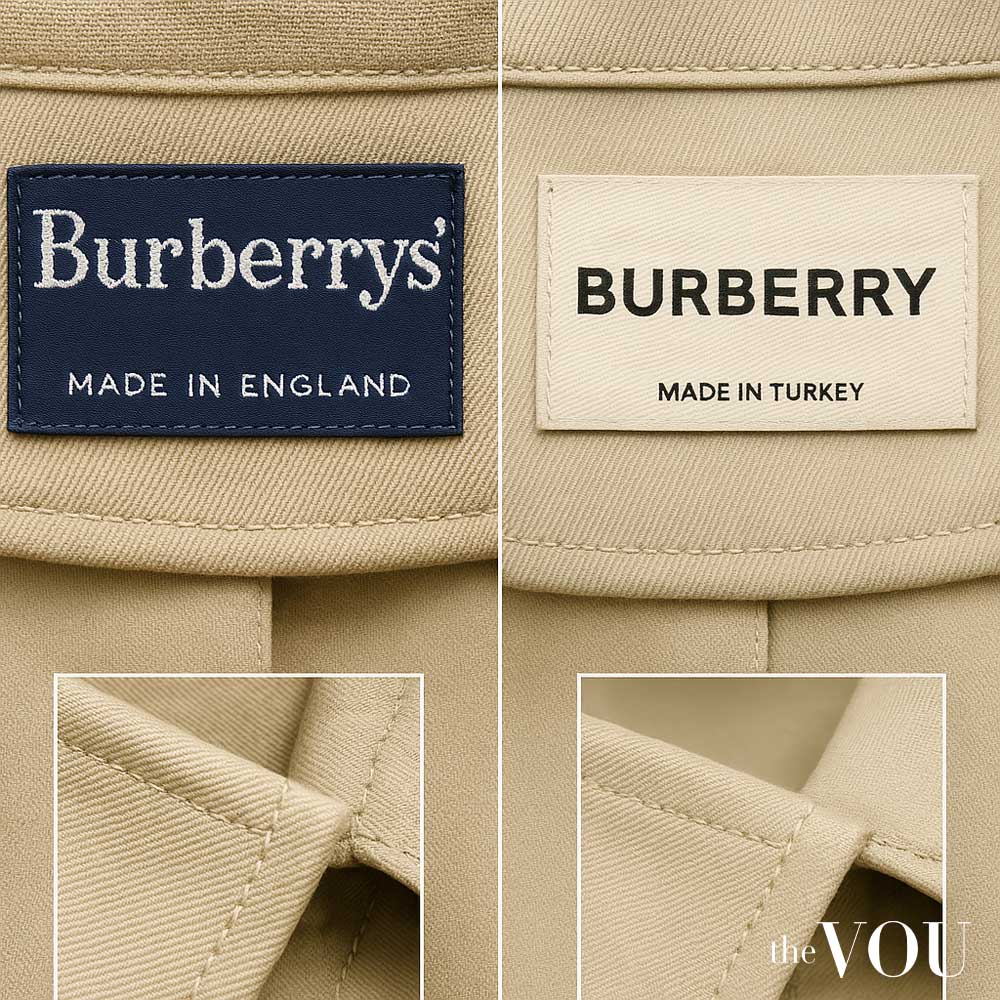
It’s important to know that Burberrys’ changed to Burberry in 1999.
Most collectors prefer the pre-1999 trench coats to post-1999 versions because they were made in England, with a higher focus on quality.
Today, Burberry is more of a premium fashion label than a reliable manufacturer of top-quality, functional garments.
Trench modern Burberry coats have a label without the S and are post-1999 – in the best case, made in Italy but mostly in Turkey and Malaysia.
Burberrys’ vs. Burberry
Fortunately, it’s very easy to distinguish the coats when shopping for a vintage Burberry.
The trench coats from before 1999 have a label that reads’ Burberrys’ with an s and apostrophe (‘) at the end.
The font is usually white on a navy or dark blue label.
Other Burberry Labels

To complicate matters, the company has several other labels which are also used for trench coats, such as:
Burberry Black Label and Burberry Blue Label are both tailored for the Japanese market under license by Sanyo Shokai.
While a few are made in Japan, most trench coats are made in China.
In our experience, we don’t recommend these lines as quality trench coats.
Burberry’s last modern trench coat line is Prorsum, the British company’s high-end label – more fashion-forward but with a price tag to match.
If you find one you like, go for it, though it has little to do with the traditional trench coats Burberrys’ became famous for.
Authentic or Fake Burberry Trench Coat?
Due to the popularity of the Trench Coat and the Burberry brand, you will occasionally find counterfeit Burberry trench coats.
Fortunately, most fakes are of low quality and relatively easy to spot.
These are the things you should pay attention to when searching for quality (pre-1999) Burberry Trench Coats:
Neat Stitching
Genuine Burberry trench coats feature neat seams and stitching.
For example, the belt loops are carefully reinforced with a little square stitch, whereas fakes often feature sloppy stitching and little attention to detail.
Matching Nova Check Pattern
On genuine Burberrys’ trench coats, the Nova Check lining matches up neatly, always in beige, white, black, and red.
Different colours or mismatched checks are a hallmark of fakes.
Correct Labels
Genuine pre-1999 trench coats have a white label in the left pocket with a Name and Order field. The size is always in the Name field.
The size label is hidden underneath the navy blue Burberry’s label on the liner.
If you cannot find these labels and they were not removed, the trench coat is a fake.
Quality Gabardine Fabric
Available in 100% cotton, 51% Cotton, 49% Polyester, 67% Polyester, and 33% Cotton, the Burberry Gabardine is very hard-wearing and anything but flimsy.
Any other composition is not genuine.
Trench Coat History and Roots
The Trench Coat has come a long way from the battlefields of the 19th century.
As far as overcoats go, the Trench Coat is about as iconic as they come. Men of all tastes appreciate it for its classic form and functionality.
As with many garments today, there are numerous theories about the exact origins of the trench coat.
While we may never know the true story, here are the most likely beginnings of the trench coat as we know it today.
Macintosh Trench Coats
It seems that the 18th-century coachman’s coat – also the predecessor of the greatcoat– was likely the forefather of the trench coat.
Unlike modern designer garments, each characteristic feature of the trench was born out of practicality.
Today, the trench coat is classified as a raincoat, which brings us to our starting point at the beginning of the nineteenth century.
Gas lighting was becoming increasingly popular at the time, and in Glasgow, Scotland, the gas was derived from coal.
In 1818, the Scotsman James Syme realised that coal-tar naphtha, a by-product, could dissolve rubber.
As has occurred so many times in history, the inventor/discoverer passed on his information to a savvy businessperson—in this case, Charles Macintosh, who had successfully made a lot of money with dry bleach.
By 1823, Macintosh had found a way to use this adhesive rubber solution in garments.
He applied it between two layers of cloth, resulting in a waterproof raincoat that did not feel like rubber.
Although this raincoat had a most unpleasant odour, Charles Macintosh & Co. was founded in 1824 in Manchester, England, home to the cotton mills that provided the raw materials for the raincoats.
However, the material had a heavy smell and undesired properties – like honey in the heat and hard as a board in the cold – which saw the coat fall out of favour by the late 1830s.
Advances in production were made, so by 1854, the company Hellewell advertised the five-ounce reversible Paletot, which looked more fashionable and was popular with anybody who had to face the elements.
Overall, the second incarnation of the raincoat was so popular that they were referred to as “Macintoshes”, which is why you might hear people referring to them as “rain mac”.
Nowadays, the Mackintosh coat bears the letter ‘k’ in the name Mackintosh, and the company is now Japanese-owned.
Aquascutum Trench Coats
While the Manchester rainwear production was about to peak, a gentleman from southern England named John Emary worked on his raincoat version.
Eventually, Emary developed a special raincoat called Aquascutum, derived from the Latin aqua, which means water, and scutum, which means shield.
Made for British soldiers in the company’s tailor’s shop launched on Regent Street in 1851, Aquascutum coats were double-breasted and had an ankle length.
Beginning in 1853, the raincoat was produced in larger numbers for the British military and used in the Crimean War.
It even appeared during the American Civil War (1861 – 1865), the Boer Wars, and the Russo-Japanese War (1904 – 1905).
World’s Oldest Trench Coat
Today’s oldest likely ‘trench’ coat is the Aquascutum of Lt. General Gerald Goodlake, preserved at Newstead Abbey, England.
He wore this coat during the Crimean War, where he commanded a sharpshooter force.
The grey coat made of an all-wool cloth by a famous West of England mill and worn by Goodlake is showcased next to the general’s uniform.
Burberry Trench Coats
In 1856, a 21-year-old draper’s apprentice, Thomas Burberry, opened an outerwear shop in Basingstoke, England.
Since he had grown up in the countryside, he noticed that the linen garments of farm workers had certain properties that he wanted to transfer to overcoats and topcoats.
This farmer’s clothing was lightweight and not constricting, warm in the winter, breathable in the summer, and shower-resistant when damp because the material shrank once it got moist.
Although Aquascutum was the first to produce large-scale weatherproofed raincoats, by the 1870s, Thomas Burberry had developed into a fierce competitor.
Unlike the rubberised version of Emary, Burberry followed a different approach.
Instead of wool, he used sturdy fabric of long-strung Egyptian cotton yarn that was waterproofed before and after the weaving.
He called it Gabardine—today also known as Gaberdine—which was, in fact, an old term that was outdated at the time.
The advantages were that it was lightweight, odour-free, hard-wearing, and waterproof. In 1879, he registered the term Gabardine as a trademark, which lasted 40 years.
World explorers like Amundsen and Shackleton used Gabardine for their exhibitions, which was widely used during the Boer Wars.
Lord Kitchener’s Trench Coat
Field Marshal Lord Kitchener cut an iconic British figure with a moustache and a trench coat.
His preferred model was the Tielocken model, patented in 1912 as a coat with a strap and a buckle instead of buttons and buttonholes.
Many officers aspired to follow him, and when he died on a sinking ship during the war, he supposedly wore his trench coat, helping to cement the coat’s then-legendary status.
Battlefield Roots
Despite Burberry’s prominent proponents, Aquascutum’s loyal following sent back raving letters from the front lines, which became part of Aquascutum’s advertising campaigns.
During WWI, trench coats were cut in different lengths; they were generally shorter, and sometimes, they reached above the knee to aid movement in the cramped and narrow trenches.
They also featured epaulettes and D-rings. Almost as famous as the sand, olive, and khaki colours were blue & grey gabardine with a checked lining.
While some suspect that this was a designer’s invention of the 20th century, checked-lined rainwear was, in fact, the standard in the 1880s and 1890s.
There was a period in the mid-twentieth century when trench coats were often lined in solid colours, but today, the checked lining is just as distinctive as the outer shell.
The trench coat remained very popular during the interwar years, and there are a few key reasons.
Firstly, in Britain, the government had ordered thousands of trench coats and found itself with a hefty surplus at the war’s end, distributed to the public in the 1920s.
Secondly, officers were happy to wear their uniforms in civilian life, especially since these garments were tough and hard-wearing and fabric remained a scarce commodity.
Thirdly, Hollywood stars showcased the trench coat in films across the US, many of which are cultural treasures; think of Casablanca and Humphrey Bogart or the Maltese Falcon.
World War II Trench Coats
Since WWII’s combat strategies were different and less trench-focused than WWI’s, shorter, multi-functional field jackets (some even camouflaged) were now the garment of choice, and the trench coat lost its military significance.
Of course, you’ve probably seen photographs of German officers in black leather trench coats from then, but these were worn to make an impression rather than for their practicality.
Nevertheless, the trench coat remained popular with the public thereafter.
Aquascutum blended newly-invented nylon with cotton to create water and wind-resistant fabrics such as Aqua 5, long before Gore-Tex & Windstopper became household names.
In the following decades, the trench coat has been popular with countless designers for men and women alike.
Trench Coat FAQs
What is a Classic Trench Coat?
The classic trench coat is a double-breasted overcoat made from Gabardine, a waterproof type of cotton.
It should reach the knees and have several defining features, such as a gun flap and belt with D-rings.
What is the Best Trench Coat for Men?
Many excellent trench coat options for men are available, however, collectors are prizing the pre-1999 Burberrys’ classic models.
While these can be challenging to find, there are many excellent options from several different heritage brands on the vintage market, including Macintosh and Aquascutum.
When Should Men Wear Trench Coats?
Trench coats are ideal for men interested in depicting a classic, old-money fashion style;
A trench coat could arguably be considered an all-season piece, as it can be configured to suit many different situations, including rain, wind, and snow.
What to Wear Under a Trench Coat?
Traditionally, trench coats were intended for soldiers who wore bulky uniforms underneath them.
Nowadays, trench coats can be worn with almost anything underneath, including suits, sweaters, and even plain t-shirts paired with denim jeans and casual footwear.
Should a Trench Coat be Fitted or Loose?
Trench coats, originally military garments, are designed with a looser fit for added mobility.
Classic trench coats should still fit you well, unlike the oversized trends seen in the 1980s, but shouldn’t be so tight that you can’t fit it over a jacket, like the skinny fit trends of the 2000s.
What is the Point of a Trench Coat?
Trench coats were originally designed to protect soldiers from the harsh conditions in the trenches, hence their name.
Following their use in the war, trench coats became extremely popular as everyday protection from adverse weather, including high winds and heavy rain.
Are Trench Coats for Winter?
Trench coats can be excellent when it comes to transitional seasons, as well as the depths of winter.
A trench coat with a removable wool liner allows you to add another layer of warmth to help keep the cold at bay.
What is the Best Colour for a Trench Coat?
Traditional trench coats come in a wonderful shade of khaki. However, you can find trench coats in many different colours.
A darker colour, such as grey, navy, or black, can be a great option for travel.
Can Trench Coats be Styled with Everything?
While the trench coat’s design makes it extremely versatile for almost all kinds of occasions, this garment can look out of place in a few scenarios, particularly when combined with summer and evening wear.
While you may want an additional layer during the summertime, wearing a trench coat will make you look over the top.
Regarding formality, occasions requiring more attention (such as black or white tie dress codes) are also areas to skip the trench coat and opt for something more formal.
Take the First Step With The VOU’s Styling Quizzes
Start your style journey with our free resources. First, take our Face Shape Quiz to confirm your face shape and receive initial styling guidance.
Then, discover your most flattering colours with our Seasonal Colour Analysis Quiz.
Learn which garment styles suit you best through our Body Shape Quiz, and find your ideal personal style with our Fashion Style Quiz.
Transform Your Image with The VOU’s Professional Guidance
For comprehensive image development that goes beyond hat selection, The VOU offers expert styling services to ensure your complete look projects success and sophistication.
Our Professional Face Shape Analysis package provides you with a scientific analysis of your exact face shape, personalised hairstyle recommendations, customised facial hair styling guide, expert eyewear selection guidance, and detailed grooming recommendations tailored to your unique features.
For the most comprehensive transformation, consider our Complete Image Transformation Package.
This premium service includes our Professional Face Shape Analysis, Seasonal Colour Analysis, Body Shape Analysis, Fashion Style Analysis, Wardrobe Curation Guide, and Personal Brand Development.
Through this complete package, you’ll develop a cohesive style that communicates success and sophistication across all aspects of your appearance.
With years of expertise in high-end fashion collabs and a PhD in Sustainable Fashion, Ru specialises in eco-luxe wardrobes for the modern gentleman seeking understated refinement.
With over twenty years of front-row fashion and styling events, collabs with haute-couture houses, and a PhD in Luxury Fashion, Laurenti is an expert in crafting personalised looks that depict old-money sophistication.
After years of managing hundreds of fashion brands from London's office of a global retailer, Mandy has ventured into freelancing. Connected with several fashion retailers and media platforms in the US, Australia, and the UK, Mandy uses her expertise to consult for emerging fashion brands create top-notch content as an editorial strategist for several online publications.

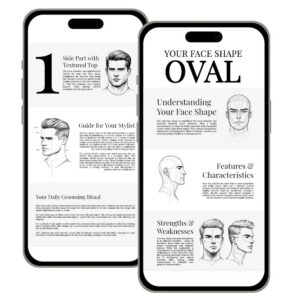 Professional Face Shape Analysis for Men
Professional Face Shape Analysis for Men 
